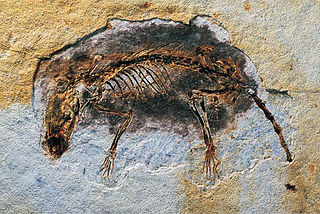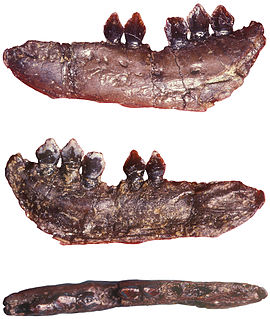
Eomaia is a genus of extinct fossil mammals containing the single species Eomaia scansoria, discovered in rocks that were found in the Yixian Formation, Liaoning Province, China, and dated to the Barremian Age of the Lower Cretaceous about 125 million years ago. The single fossil specimen of this species is 10 centimetres (3.9 in) in length and virtually complete. An estimate of the body weight is between 20–25 grams (0.71–0.88 oz). It is exceptionally well-preserved for a 125-million-year-old specimen. Although the fossil's skull is squashed flat, its teeth, tiny foot bones, cartilages and even its fur are visible.

Sunnyodon is a genus of tiny, extinct mammal, probably of the Lower Cretaceous. Found in what is now southern England and Denmark, it was a relatively early member of the extinct order of Multituberculata. It is part of the suborder Plagiaulacida and family Paulchoffatiidae.

Metatheria is a mammalian clade that includes all mammals more closely related to marsupials than to placentals. First proposed by Thomas Henry Huxley in 1880, it is a slightly more inclusive group than the marsupials; it contains all marsupials as well as many extinct non-marsupial relatives.

Echinodon is a genus of heterodontosaurid dinosaur that lived during the earliest Cretaceous of southern England in the Berriasian epoch. The first specimens were jaw bones named Echinodon becklesii by Sir Richard Owen in 1861, and since their original description only additional teeth have been discovered. The specific name honours collector Samuel Beckles who discovered the material of Echinodon and many other taxa from across England, while the genus name translates as "prickly tooth" in reference to the dental anatomy of the taxon.

Akidolestes is an extinct genus of spalacotheriid mammal.
Cimolestes is a genus of early eutherians with a full complement of teeth adapted for eating insects and other small animals. Paleontologists have disagreed on its relationship to other mammals, in part because quite different animals were assigned to the genus, making Cimolestes a grade taxon of animals with similar features rather than a genus of closely related ones. Fossils have been found in North America, South America, Europe and Africa. Cimolestes first appeared during the Late Cretaceous of North America. According to some paleontologists, Cimolestes died out at the start of the Paleocene, while others report the genus from the early Eocene.

Leptictida is a possibly invalid extinct order of placental mammals. Their classification is contentious: according to cladistic studies, they may be (distantly) related to Euarchontoglires, although they are more recently regarded as the first branch to split from basal eutherians. One recent large-scale cladistic analysis of eutherian mammals favored lepictidans as close to the placental crown-clade; and several other recent analyses that included data from Cretaceous non-eutherian mammals found Leptictis to belong to the superorder Afrotheria.
Tinodon is an extinct genus of mammal alive 155-140.2 million years ago (Oxfordian-Berriasian) which has been found in the Morrison Formation, the Alcobaça Formation (Portugal) and the Lulworth Formation (England). It is of uncertain affinities, being most recently recovered as closer to therians than eutriconodonts but less so than allotherians. Two species are known: T. bellus and T. micron.
Pappotherium is an extinct genus of mammals from the Albian of Texas, US, known from a fossilized maxilla fragment bearing two tribosphenic molars, discovered within the Glen Rose Formation near Decatur, Wise County, Texas.

Triconodon is a genus of extinct mammal from the Early Cretaceous of England and France with two known species: T. mordax and T. averianovi. First described in 1859 by Richard Owen, it is the type genus for the order Triconodonta, a group of mammals characterised by their three-cusped (triconodont) molar teeth. Since then, this "simplistic" type of dentition has been understood to be either ancestral for mammals or else to have evolved multiple times, rendering "triconodonts" a paraphyletic or polyphyletic assemblage respectively, but several lineages of "triconodont" mammals do form a natural, monophyletic group, known as Eutriconodonta, of which Triconodon is indeed part of.

Durlstotherium is an extinct genus of mammal from the Early Cretaceous. It contains a single species, Durlstotherium newmani. The type specimen was found in Durlston Bay, Dorset, after which the genus was named. D. newmani was named after a British pub landlord, Charlie Newman. Durlstotherium and two of its contemporaries, Tribactonodon and Durlstodon, had tribosphenidan (three-cusped) molars, which are an advanced characteristic among eutherian mammals and suggest that the group emerged earlier than the Early Cretaceous.

Peramus is an extinct genus of cladotherian mammal. It lived in the Late Jurassic and Early Cretaceous of Europe and North Africa.

Phascolestes is a genus of extinct mammal from the Berriasian epoch of Early Cretaceous Southern England. The type and only species is Phascolestes mustelulus, which was named by Richard Owen in 1871 for dental material from the Lulworth Formation. Phascolestes is a close relative of co-existing taxon Achyrodon within the subfamily Kurtodontinae of the family Dryolestidae, with Kurtodon being a junior synonym of Phascolestes although the subfamily name is still applicable.
Spalacotherium is a genus of extinct mammal from the Early Cretaceous of Europe. The type species Spalacotherium tricuspidens was originally named by Richard Owen in 1854, and its material includes maxillary and dentary fragments and many teeth from the Berriasian Lulworth Formation of southern England. Referred species include S. taylori, S. evansae and S. hookeri also from the Lulworth deposits, and S. henkeli from Barremian deposits of Galve, Spain. The Lulworth taxon Peralestes longirostris, named by Owen in 1871, is a junior synonym of the type species S. tricuspidens. Spalacotherium is the namesake taxon of the family Spalacotheriidae, which is an extinct clade within Trechnotheria that may be closely related to the Gondwanan clade Meridiolestida, or united with the family Zhangheotheriidae to form Symmetrodonta.
Chunnelodon is a genus of extinct mammal from the Early Cretaceous of Southern England. The type and only species is Chunnelodon alopekodes, represented by two lower molars from the Sunnydown Farm locality of the Lulworth Formation of Dorset. The taxon was described by Paul Ensom and Denise Sigogneau-Russell in 1998, who gave the species name from the translation of the Ancient Greek phrase "sly as a fox", with the generic name honouring the British-French collaboration and the newly inaugurated Channel Tunnel. Chunnelodon is diagnosed by multiple features of the dental anatomy including slightly asymmetrical but aligned roots, sharp cusps, a tall protoconid and metaconid, a small paraconid, and a reduced talonid. While it was only assigned to Cladotheria indeterminate, Chunnelodon was likely closely related to Dryolestoidea, although outside the clade.
Thereuodon is a genus of extinct mammal known from the Early Cretaceous of southern England and Morocco. The type species, named by Denise Sigogneau-Russell in 1989 for teeth from the earliest Cretaceous deposits of Morocco, is Thereuodon dahmani, while the referred species named by Sigogneau-Russell and Paul Ensom for teeth from the Lulworth Formation of England is Thereuodon taraktes. The two species are separated by a break in the cingulum in T. dahmani, a more obsute medial crest in T. taraktes, a duller stylocone in T. taraktes, a "c" cuspule in T. dahmani, and a reduced facet A in T. taraktes. The genus Thereuodon is the only taxon in the symmetrodont family Thereuodontidae, which may be closely related to Spalacotheriidae.
Peramuroides is a genus of extinct mammal from the Early Cretaceous of southern England. The type and only species is Peramuroides tenuiscus, described in 2012 by Brian Davis for dentary fragments and teeth from the Berriasian Lulworth Formation. The genus name references closely related Peramus, while the species name is based on the Latin word for "thin". Peramuroides is closely related to coexisting genera Peramus and Kouriogenys, and along with other genera these make up the family Peramuridae, a group of extinct zatherians.
Magnimus is a genus of extinct mammal from the Early Cretaceous of Southern England. The type and only species is Magnimus ensomi, described in 1999 by Denise Sigogneau-Russell for molars from the Berriasian Lulworth Formation. The specific name was given to honour Paul Ensom, a discoverer of many teeth from the Purbeck beds, while the generic name is from the Latin words for "large" and "mouse". It is similar to but distinct from Peramus and Abelodon, but its classification cannot be narrowed down beyond indeterminate Zatheria due to its incomplete nature.
Azilestes is a genus of probable zhelestid eutherian, a family consisting of small herbivores, that was discovered in the early Maastrichtian Grès de Labarre Formation of France. It is a monotypic genus, with only type species A. ragei being known. Only one specimen, the holotype described in 2021, is known. It consists of a partial dentary with teeth, and was discovered in sediments belonging to the Grès de Labarre Formation of France.

Gypsonictops is an extinct genus of leptictidan mammals of the monotypic family Gypsonictopidae, which was described in 1927 by George Gaylord Simpson. Species in this genus were small mammals and the first representatives of the order Leptictida, that appeared during the Upper Cretaceous.
















